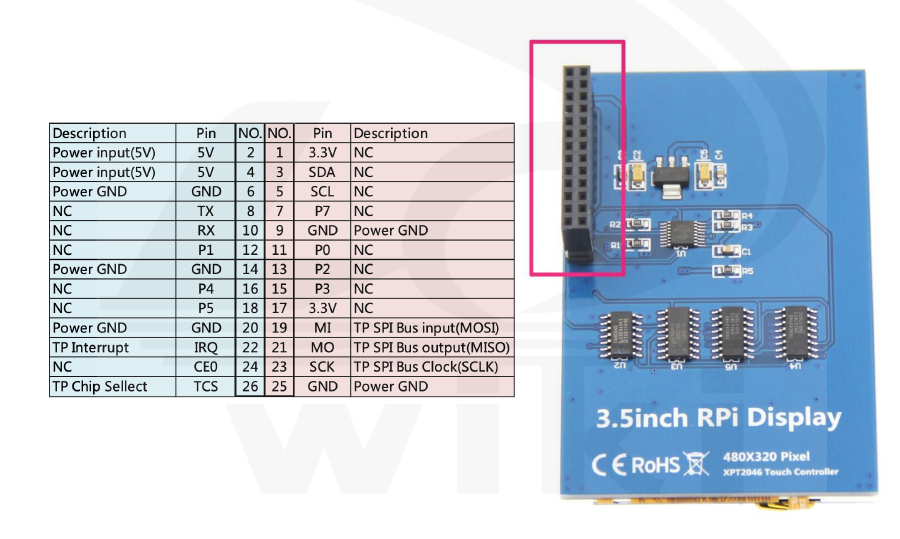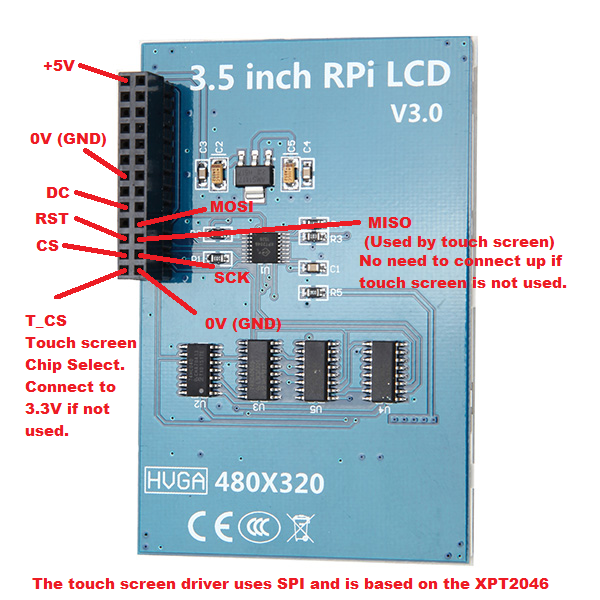TFT 3.5 LCD Raspberry: Skirtumas tarp puslapio versijų
| 7 eilutė: | 7 eilutė: | ||
ESP8266 NodeMCU support for spi interface displays https://github.com/Bodmer/TFT_eSPI | ESP8266 NodeMCU support for spi interface displays https://github.com/Bodmer/TFT_eSPI | ||
| + | Lib konfigūracija: | ||
| + | #define RPI_ILI9486_DRIVER | ||
| + | #define SPI_FREQUENCY 20000000 | ||
| + | #define TOUCH_CS PIN_D2 // Chip select pin (T_CS) of touch screen | ||
| + | |||
| + | Pajungimo schema: | ||
* Display SDO/MISO to NodeMCU pin D6 | * Display SDO/MISO to NodeMCU pin D6 | ||
* Display LED to NodeMCU pin VIN (or 5V) | * Display LED to NodeMCU pin VIN (or 5V) | ||
| 12 eilutė: | 18 eilutė: | ||
* Display SDI/MOSI to NodeMCU pin D7 | * Display SDI/MOSI to NodeMCU pin D7 | ||
* Display DC (or AO)to NodeMCU pin D3 | * Display DC (or AO)to NodeMCU pin D3 | ||
| − | * Display RESET to NodeMCU pin D4 | + | * Display RESET to NodeMCU pin D4 (or RST, see below) |
| − | * Display CS to NodeMCU pin D8 | + | * Display CS to NodeMCU pin D8 (or GND, see below) |
* Display GND to NodeMCU pin GND (0V) | * Display GND to NodeMCU pin GND (0V) | ||
* Display VCC to NodeMCU 5V or 3.3V | * Display VCC to NodeMCU 5V or 3.3V | ||
* Display Touch_CD to NodeMCU pin D1 | * Display Touch_CD to NodeMCU pin D1 | ||
| + | * Display T_CS to NodeMCU pin D2 | ||
Another lib: https://github.com/ZinggJM/ILI9486_SPI | Another lib: https://github.com/ZinggJM/ILI9486_SPI | ||
06:41, 22 lapkričio 2022 versija
ESP8266
ESP8266 NodeMCU support for spi interface displays https://github.com/Bodmer/TFT_eSPI
Lib konfigūracija:
#define RPI_ILI9486_DRIVER #define SPI_FREQUENCY 20000000 #define TOUCH_CS PIN_D2 // Chip select pin (T_CS) of touch screen
Pajungimo schema:
- Display SDO/MISO to NodeMCU pin D6
- Display LED to NodeMCU pin VIN (or 5V)
- Display SCK to NodeMCU pin D5
- Display SDI/MOSI to NodeMCU pin D7
- Display DC (or AO)to NodeMCU pin D3
- Display RESET to NodeMCU pin D4 (or RST, see below)
- Display CS to NodeMCU pin D8 (or GND, see below)
- Display GND to NodeMCU pin GND (0V)
- Display VCC to NodeMCU 5V or 3.3V
- Display Touch_CD to NodeMCU pin D1
- Display T_CS to NodeMCU pin D2
Another lib: https://github.com/ZinggJM/ILI9486_SPI
Metodas (su gfx akseleracija) be touchscreen
apt-get install cmake git git clone https://github.com/juj/fbcp-ili9341.git cd fbcp-ili9341 mkdir build cd build cmake -DILI9486=ON -DSPI_BUS_CLOCK_DIVISOR=6 .. make -j sudo ./fbcp-ili9341
Patvirtintas metodas su touchscreen
/boot/config.txt
dtparam=spi=on dtparam=i2c_arm=on dtoverlay=piscreen2r,speed=16000000,rotate=270
/boot/cmdline.txt
Pridedam į galą branduolio parametrų eilutės:
fbcon=map:10 fbcon=font:VGA2x2
pygameui fix (raspbian jessie)
The package "libsdl1.2-15-10", which ships with Debian Jessie, breaks pygame. To make it work we have to revert back to "libsdl1.2-15-5" from Wheezy.
The quickest way is to comment everything out in your /etc/apt/sources.list and temporarily add:
deb http://archive.raspbian.org/raspbian wheezy main contrib non-free
Import the corresponding keys:
deb http://archive.raspbian.org/raspbian wheezy main contrib non-free gpg -a --export 9165938D90FDDD2E | sudo apt-key add -
Remove the offending package and replace it with the working one:
sudo apt-get update sudo apt-get remove libsdl1.2debian python-pygame apt-get install libsdl-image1.2 libsdl-mixer1.2 libsdl-ttf2.0-0 libsdl1.2debian libsmpeg0 python-pygame sudo apt-mark hold libsdl1.2debian
Restore "/etc/apt/sources.list" to it's original state.
pygameui fix (raspbian stretch)
Downgradiname paketa ir nepamirstame is naujo perkalibruoti touchscreen.
TSLIB_FBDEVICE=/dev/fb1 TSLIB_TSDEVICE=/dev/input/event0 TSLIB_CALIBFILE=/etc/pointercal TSLIB_CONFFILE=/etc/ts.conf TSLIB_PLUGINDIR=/usr/lib/ts ts_calibrate
Binary Install way
wget http://devnull.eofnet.lt/stuff/raspbian_wheezy/libsdl1.2-dev_1.2.15-5~bpo9%2B1_armhf.deb wget http://devnull.eofnet.lt/stuff/raspbian_wheezy/libsdl1.2debian_1.2.15-5~bpo9%2B1_armhf.deb dpkg -i libsdl1.2debian_1.2.15-5~bpo9+1_armhf.deb dpkg -i libsdl1.2-dev_1.2.15-5~bpo9+1_armhf.deb
Source install way
mkdir /root/sources cd /root/sources wget http://legacy.raspbian.org/raspbian/pool/main/libs/libsdl1.2/libsdl1.2_1.2.15.orig.tar.gz wget http://legacy.raspbian.org/raspbian/pool/main/libs/libsdl1.2/libsdl1.2_1.2.15-5.debian.tar.gz
Or use my mirror
wget http://devnull.eofnet.lt/stuff/raspbian_wheezy/libsdl1.2_1.2.15-5.debian.tar.gz http://devnull.eofnet.lt/stuff/raspbian_wheezy/libsdl1.2_1.2.15.orig.tar.gz tar xzvf libsdl1.2_1.2.15.orig.tar.gz tar xzvf libsdl1.2_1.2.15-5.debian.tar.gz mv debian SDL-1.2.15/ cd SDL-1.2.15
Install dependencies to build the packages
apt-get install packaging-dev debian-keyring devscripts equivs
Prepare the package deps
mk-build-deps --install
Add the revision to the change file, report the backporting
dch --bpo
Build the package
fakeroot debian/rules binary dpkg-buildpackage -us -uc
Now you can install the package
dpkg -i ../libsdl1.2debian_1.2.15-5~bpo9+1_armhf.deb dpkg -i ../libsdl1.2-dev_1.2.15-5~bpo9+1_armhf.deb
/etc/X11/xorg.conf.d/99-ads7846-cal.conf
Section "InputClass"
Identifier "calibration"
MatchProduct "ADS7846 Touchscreen"
Option "Calibration" "3950 253 254 3971"
Option "SwapAxes" "0"
driver "evdev"
EndSection
Išimam iš konfigūracinių failų esančių /usr/share/X11/xorg.conf.d/ touchscreen interfeisus pvz. 40-libinput.conf esantis su Driver "libinput", būtina jį pašalinti, galima taip pat padaryti, kad naudotų draiverį "evdev". Pakeičiam 99-fbturbo.conf esantį fb0 į fb1
10-amdgpu.conf
Section "OutputClass"
Identifier "AMDgpu"
MatchDriver "amdgpu"
Driver "amdgpu"
EndSection
10-evdev.conf
Section "InputClass"
Identifier "evdev pointer catchall"
MatchIsPointer "on"
MatchDevicePath "/dev/input/event*"
Driver "evdev"
EndSection
Section "InputClass"
Identifier "evdev keyboard catchall"
MatchIsKeyboard "on"
MatchDevicePath "/dev/input/event*"
Driver "evdev"
EndSection
Section "InputClass"
Identifier "evdev touchpad catchall"
MatchIsTouchpad "on"
MatchDevicePath "/dev/input/event*"
Driver "evdev"
EndSection
Section "InputClass"
Identifier "evdev tablet catchall"
MatchIsTablet "on"
MatchDevicePath "/dev/input/event*"
Driver "evdev"
EndSection
Section "InputClass"
Identifier "evdev touchscreen catchall"
MatchIsTouchscreen "on"
MatchDevicePath "/dev/input/event*"
Driver "evdev"
EndSection
10-quirks.conf
# Collection of quirks and blacklist/whitelists for specific devices.
# Accelerometer device, posts data through ABS_X/ABS_Y, making X unusable
# http://bugs.freedesktop.org/show_bug.cgi?id=22442
Section "InputClass"
Identifier "ThinkPad HDAPS accelerometer blacklist"
MatchProduct "ThinkPad HDAPS accelerometer data"
Option "Ignore" "on"
EndSection
# https://bugzilla.redhat.com/show_bug.cgi?id=523914
# Mouse does not move in PV Xen guest
# Explicitly tell evdev to not ignore the absolute axes.
Section "InputClass"
Identifier "Xen Virtual Pointer axis blacklist"
MatchProduct "Xen Virtual Pointer"
Option "IgnoreAbsoluteAxes" "off"
Option "IgnoreRelativeAxes" "off"
EndSection
# https://bugs.freedesktop.org/show_bug.cgi?id=55867
# Bug 55867 - Doesn't know how to tag XI_TRACKBALL
Section "InputClass"
Identifier "Tag trackballs as XI_TRACKBALL"
MatchProduct "trackball"
MatchDriver "evdev"
Option "TypeName" "TRACKBALL"
EndSection
# https://bugs.freedesktop.org/show_bug.cgi?id=62831
# Bug 62831 - Mionix Naos 5000 mouse detected incorrectly
Section "InputClass"
Identifier "Tag Mionix Naos 5000 mouse XI_MOUSE"
MatchProduct "La-VIEW Technology Naos 5000 Mouse"
MatchDriver "evdev"
Option "TypeName" "MOUSE"
EndSection
40-libinput.conf
# Match on all types of devices but tablet devices and joysticks
Section "InputClass"
Identifier "libinput pointer catchall"
MatchIsPointer "on"
MatchDevicePath "/dev/input/event*"
Driver "libinput"
EndSection
Section "InputClass"
Identifier "libinput keyboard catchall"
MatchIsKeyboard "on"
MatchDevicePath "/dev/input/event*"
Driver "libinput"
EndSection
Section "InputClass"
Identifier "libinput touchpad catchall"
MatchIsTouchpad "on"
MatchDevicePath "/dev/input/event*"
Driver "libinput"
EndSection
Section "InputClass"
Identifier "libinput tablet catchall"
MatchIsTablet "on"
MatchDevicePath "/dev/input/event*"
Driver "libinput"
EndSection
70-wacom.conf
# Some of the below input classes appear 3x times, once for each of
# "tablet", "touchscreen", and "touchpad" to ensure that the Wacom
# driver is not accidentally bound to other types of hardware that
# Wacom has made which are not handled by the wacom driver (e.g the
# Wacom Bluetooth Keyboard)
#
# https://sourceforge.net/p/linuxwacom/bugs/294/
Section "InputClass"
Identifier "Wacom USB tablet class"
MatchUSBID "056a:*"
MatchDevicePath "/dev/input/event*"
MatchIsTablet "true"
Driver "wacom"
EndSection
Section "InputClass"
Identifier "Wacom USB touchscreen class"
MatchUSBID "056a:*"
MatchDevicePath "/dev/input/event*"
MatchIsTouchscreen "true"
Driver "wacom"
EndSection
Section "InputClass"
Identifier "Wacom USB touchpad class"
MatchUSBID "056a:*"
MatchDevicePath "/dev/input/event*"
MatchIsTouchpad "true"
Driver "wacom"
EndSection
Section "InputClass"
Identifier "Wacom tablet class"
MatchProduct "Wacom|WACOM|PTK-540WL|ISD-V4"
MatchDevicePath "/dev/input/event*"
MatchIsTablet "true"
Driver "wacom"
EndSection
Section "InputClass"
Identifier "Wacom touchscreen class"
MatchProduct "Wacom|WACOM|PTK-540WL|ISD-V4"
MatchDevicePath "/dev/input/event*"
MatchIsTouchscreen "true"
Driver "wacom"
EndSection
Section "InputClass"
Identifier "Wacom touchpad class"
MatchProduct "Wacom|WACOM|PTK-540WL|ISD-V4"
MatchDevicePath "/dev/input/event*"
MatchIsTouchpad "true"
Driver "wacom"
EndSection
# Serial Wacom devices should always be one of tablet, touchscreen, or
# touchpad so we can safely get away with just one match section in
# these cases
Section "InputClass"
Identifier "Wacom PnP device class"
MatchPnPID "WACf*|WCOM*|WACM*|FUJ02e5|FUJ02e7|FUJ02e9"
MatchDevicePath "/dev/input/event*"
Driver "wacom"
EndSection
Section "InputClass"
Identifier "Wacom serial class"
MatchProduct "Serial Wacom Tablet"
Driver "wacom"
EndSection
Section "InputClass"
Identifier "Wacom serial class identifiers"
MatchProduct "WACf|FUJ02e5|FUJ02e7|FUJ02e9"
Driver "wacom"
EndSection
# Hanwang tablets
Section "InputClass"
Identifier "Hanwang class"
MatchProduct "Hanwang"
MatchDevicePath "/dev/input/event*"
Driver "wacom"
EndSection
# Waltop tablets
Section "InputClass"
Identifier "Waltop class"
MatchProduct "WALTOP"
MatchIsTablet "on"
MatchDevicePath "/dev/input/event*"
Driver "wacom"
EndSection
# N-Trig Duosense Electromagnetic Digitizer
Section "InputClass"
Identifier "Wacom N-Trig class"
MatchProduct "HID 1b96:0001|N-Trig Pen|N-Trig DuoSense"
MatchDevicePath "/dev/input/event*"
Driver "wacom"
Option "Button2" "3"
EndSection
799-fbturbo.conf
Section "Device"
Identifier "Allwinner A10/A13 FBDEV"
Driver "fbturbo"
Option "fbdev" "/dev/fb1"
# Option "SwapbuffersWait" "true"
EndSection
Kataloge /etc/X11/xorg.conf.d/ failų apart mūsų įdeto 99-ads7846-cal.conf daugiau nėra.
Kivy GUI toolkit
Prieš pradėdami, atnaujiname sistemą:
pi@raspberrypi ~ $ sudo apt-get update && sudo apt-get -y upgrade
Perkrauname:
pi@raspberrypi ~ $ sudo reboot
Įdiegiame paketus
pi@raspberrypi ~ $ sudo apt-get -y libffi-dev install libpango1.0-dev libcogl-pango-dev libsdl2-ttf-dev libsdl2-mixer-dev libsdl2-image-dev libsdl2-gfx-dev libsdl2-dev libsdl-ttf2.0-dev libsdl-sge-dev libsdl-pango-dev libsdl-ocaml-dev libsdl-console-dev libsdl2-dev libsdl2-image-dev libsdl2-mixer-dev libsdl2-ttf-dev \
pkg-config libgl1-mesa-dev libgles2-mesa-dev \
python-setuptools libgstreamer1.0-dev git-core \
gstreamer1.0-plugins-{bad,base,good,ugly} \
gstreamer1.0-{omx,alsa} python-dev libmtdev-dev \
xclip xsel
Įdiegiame pip iš source
pi@raspberrypi ~ $ curl https://bootstrap.pypa.io/get-pip.py -o get-pip.py pi@raspberrypi ~ $ sudo python get-pip.py
Įdiegiame kitus reikalingus paketus:
pi@raspberrypi ~ $ pip install -U Cython==0.28.2 pi@raspberrypi ~ $ sudo pip install pygments docutils
Pagaliau galime įdiegti kivy:
pi@raspberrypi ~ $ git clone https://github.com/kivy/kivy pi@raspberrypi ~ $ cd kivy pi@raspberrypi ~/kivy $ python setup.py build pi@raspberrypi ~/kivy $ sudo python setup.py install
Norint įgalinti touchscreen reikia padaryti keletą modifikacijų kivy konfigūraciniame faile, pirmiausia paleiskime:
pi@raspberrypi ~/kivy $ python ~/kivy/examples/demo/pictures/main.py
Bus sukurtas kivy konfigūracinis failas, kurį atsidarysime:
pi@raspberrypi ~/kivy $ nano ~/.kivy/config.ini
Einame į [input] sekciją, išimame esančias eilutes ir pridedame šias:
mouse = mouse mtdev_%(name)s = probesysfs,provider=mtdev hid_%(name)s = probesysfs,provider=hidinput
Paleidžiame kitą demo ir išbandome (patampome, paspaudžiame, bandome tempti):
pi@raspberrypi ~/kivy $ python ~/kivy/examples/demo/pictures/main.py
Išbandome kitus demo:
pi@raspberrypi ~/kivy $ python ~/kivy/examples/demo/showcase/main.py
Taip pat yra daugelis kitų direktorijoje ~/kivy/examples/.
|
FIXME
|
Reziume gauname totalų šūdą kuris segfaultina norint paleisti be X'o... Laukiam kol sutvarkys kivy, jog veiktu be Xorg palaikymo, tik sdl'e.
raylib-go
apt-get update&&apt-get install libbsd-dev rpi-update wget https://dl.google.com/go/go1.12.5.linux-armv6l.tar.gz tar -C /usr/local -xzf go1.12.5.linux-armv6l.tar.gz
Sudedame į /etc/profile ir /root/.bashrc:
export GOPATH=$HOME/go
export RPI_HOME=/opt/tools/arm-bcm2708/arm-linux-gnueabihf
export PATH=${RPI_HOME}/bin:/usr/local/go/bin:$PATH:$GOPATH/bin
Sudiegiame biblioteką
go get github.com/gen2brain/raylib-go/raylib
Sudedam mirrorinima i mūsų LCD:
git clone https://github.com/AndrewFromMelbourne/raspi2fb.git cd raspi2fb&&mkdir build&&cd build&&cmake ..&&make&&make install
Taip pat reiktų nustatyti LCD rezoliuciją į mažesnę, kadangi mirrorinimas HDMI išėjimo į rezoliuciją pvz.: 480x320, bus nelabai įskaitomas. Prirašome eilutę į /boot/config.txt:
hdmi_cvt 480 320 60 1 0 0 0 framebuffer_width=480 framebuffer_height=320
Paleidžiame mirrorinimą:
/usr/local/bin/raspi2fb --daemon
Padarome, kad mirrorinimas vyktų sistemos startavimo metu:
cd ..&&mv raspi2fb\@.service /etc/systemd/system/&&systemctl daemon-reload&&systemctl enable raspi2fb@1.service
Sukalibruojame ekrana:
TSLIB_FBDEVICE=/dev/fb1 TSLIB_TSDEVICE=/dev/input/event0 TSLIB_CALIBFILE=/etc/pointercal TSLIB_CONFFILE=/etc/ts.conf TSLIB_PLUGINDIR=/usr/lib/ts ts_calibrate
Taip pat sukuriame tslib pagalba naują touchscreen input:
TSLIB_FBDEVICE=/dev/fb1 TSLIB_TSDEVICE=/dev/input/event0 TSLIB_CALIBFILE=/etc/pointercal TSLIB_CONFFILE=/etc/ts.conf TSLIB_PLUGINDIR=/usr/lib/ts ts_uinput -v -d
/dev/input/event0 yra mūsų touchscreen (Įsitikinkite, kad ten būtent jis), paleidus turėtų ateiti grąžinimas pvz.:
/dev/input/event1
Tai ir bus mūsų naujas event device'as
package main
import "github.com/gen2brain/raylib-go/raylib"
func main() {
rl.InitWindow(800, 450, "raylib [rpi] example - basic window")
rl.SetTargetFPS(60)
for !rl.WindowShouldClose() {
rl.BeginDrawing()
rl.ClearBackground(rl.RayWhite)
rl.DrawText("Congrats! You created your first window!", 190, 200, 20, rl.LightGray)
rl.EndDrawing()
}
rl.CloseWindow()
}
go build main.go ./main

